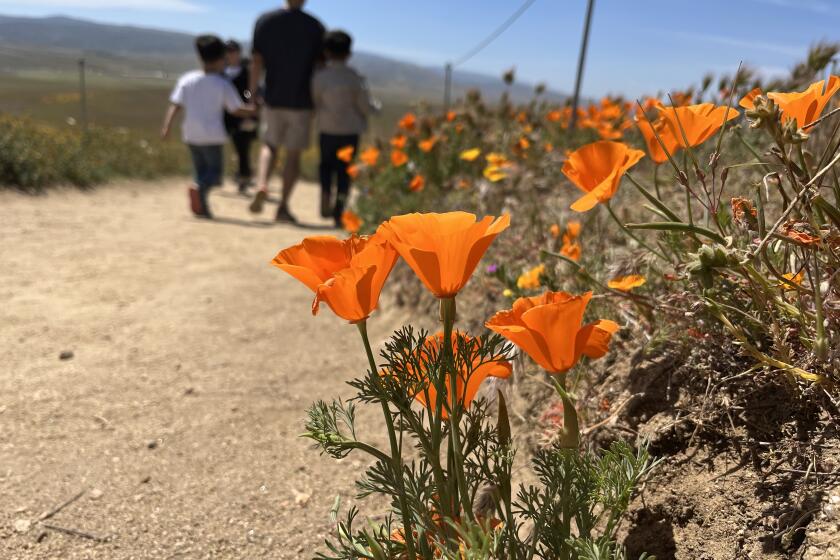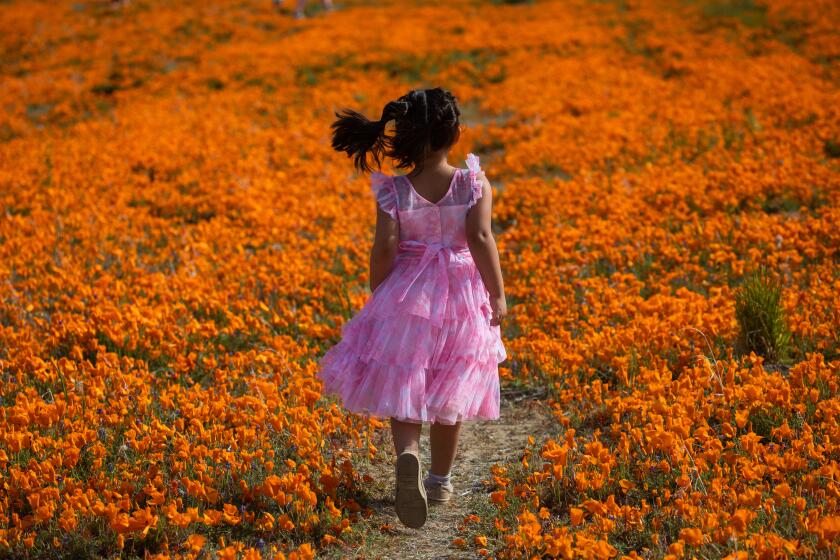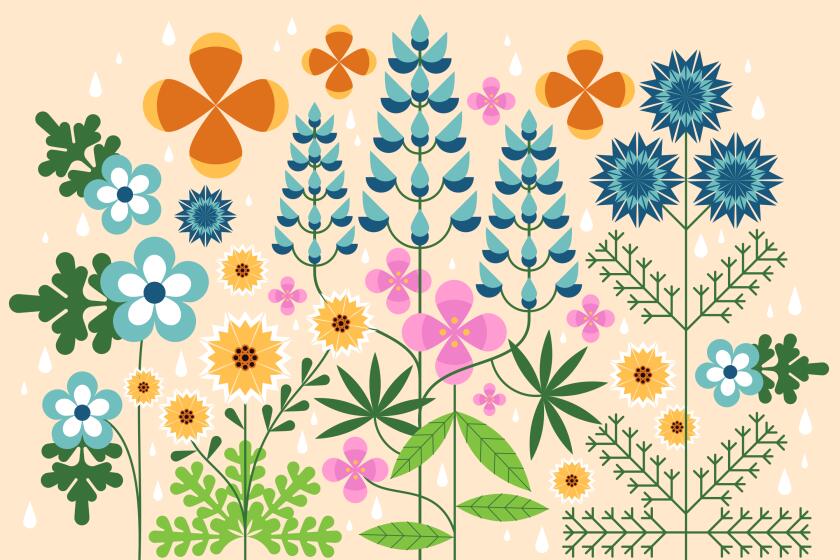Parking-strip paradise, sidewalk superbloom

- Share via
Mine is not a private garden, like those of English aristocrats or wealthy Americans, hidden behind tall gates and hedges. It’s a superbloom for my community.
All day and night, people immerse themselves in the parking strip in front of my house — 110 feet long and 6 feet wide. Teen boys pick bouquets for their dates, children poke their fingers into the vivid black crosses inside the red Flanders poppies standing taller than they do. Sometimes elderly people cry, telling me they haven’t seen sunflowers like that since Kansas. My letter carrier pauses, takes a daily picture of the scarlet Mister Lincoln and silvery-pink Our Lady of Guadalupe roses — a great combination in name and color — and texts people: Stop and smell the roses!
Mine is a California garden, with native golden poppies and wild filaree mixed in with the love-in-a-mist and tall larkspur. It grows in a working-class Riverside neighborhood, the flowers leaning over the curb into the bike lane of a wide avenue, nodding in the wake of big pickups and contractor vans, lowriders and Harleys, and parents squiring kids in minivans.
Lots of people honk when they see me out weeding — I’ve lived in this house for 35 years, and I was born in the hospital three blocks down the street, as were my ex-husband and our daughters. I lift my hand to hundreds of my friends and family in a week. People pull over, I lean into the passenger window, my hands covered with dirt and seeds. “Girl,” my sister-in-law’s friend said last week, “Tina told me your house had all the flowers, so I knew I could find you!”
Some hillsides are bathed in bright orange, but colors in the state reserve are more muted this spring.
I’ve been out weeding all spring, with my hula hoe and my bare hands. My mother taught her kids to pull hard on dandelions, mustard weed, purslane and wild foxtails. “Get the roots out or you’ll have to come back next week and do the same place again.” She meant that she’d make us do it again. When my husband and I bought this house, in April 1988, my mother brought her purple iris bulbs, and my father-in-law brought his yellow iris bulbs. Those flowers still rise along the fence, and every year I divide them and give away heirloom irises.
My own three daughters are grown now, living in other places, but they helped me weed when they were small. My girls knew to pull from the roots. I washed their small hands in the ancient cast-iron farmhouse sink in my kitchen, just as the people who lived here back in 1910, when the house was built, washed theirs.
In 1988, when we got the house, the owner was 95, a widower. There was still a hitching post in the parking strip. For horses. No lawn. And nothing but dirt around the hitching post. Near the house, one ancient apricot tree, hardy mock orange hedges and 10 roses still bloomed. I kept the tree and roses alive, with my mother’s insistent help. You never let fruit or flowers die. Never.
My mother is Swiss, a tidy perfectionist who planted annuals and vegetables in rows and never ever let things go to seed. No mess. She was appalled at the system my girls and I developed. I planted one six-pack of red Flanders poppies inside the fence my husband built along the sidewalk. Children love seed packets — by the handful, mine added larkspur, love-in-a-mist and Italian sunflowers in all colors — white, orange, yellow, red.
Photos from across Southern California show the beginning of a superbloom. We mapped out seven spots where you can go see it over the next month.
The beds around our house turned glorious. My daughters, like me, were sentimental. We didn’t want to cut anything down. Yellow finches hung upside down in the 6-foot sunflowers, scattering the seeds. The poppy seeds flew in the Santa Ana winds of summer and fall.
I have never had to buy those flowers again. Not for 35 years. But the parking strip was just weeds, dirt, trash, dog poop and an iron sprinkler system from the 1950s, anchored by two fan palms about 80 feet tall. In February of 2020, I asked for help from my landscaper friend Inez, who for years had said, “Mira, you have to do something with that! The weeds!”
She and her employees, Roberto and his son Mateo, and I attacked the dirt with picks, shovels and rakes, tearing out the ancient metal pipes. She installed PVC sprinkler heads and bought me 20 anchor plants — yellow sage, hummingbird sage and French lavender. The new perennials stood alone in the strip in March 2020, just as the world closed down and the sidewalk filled with restless people walking for their sanity.
Inez had given me the hula hoe years earlier, her favorite. Every afternoon, I hoed the strip like a farmer. Then I swept the seeds fallen to the sidewalk from the flowers inside the fence out to the bare patches by the street.
The kids in the neighborhood followed the parking strip’s progress. The plants emerging, the monarch caterpillars eating milkweed and then constructing pale green chrysalises, the blue-throated Western lizard babies darting into the new garden. Thousands of bees in the sunflowers that sprouted and grew tall amid the lavender, countless hummingbirds fighting over the sage, and yes, the poppies, darkest red, with satin petals.
When should you plant wildflower seeds in Southern California? With all the rain, January is a good time to scatter. Otherwise, November and December are best.
My youngest daughter, Rosette, back in the house during the pandemic, tipped the dried poppy lanterns and fringed larkspur pods into honey and jam jars. My middle daughter, Delphine, and her husband, Kunmi, got out the machete in hot dry September, and we dragged the sunflowers downed by fall winds along the sidewalk to the driveway, scattering next year’s seeds.
This year, with epic rainfall, the garden is a true superbloom. You can see the parking strip from blocks away, the red poppies, a public paradise.
Most evenings, a homeless man who lives by the nearby Santa Ana River stops his bike and trailer, and smokes a few cigarettes at my gate. He must be my age, always shirtless, tanned deep brown, his vertebrae visible like a string of pearls down his back, his front teeth gone, his eyes blue as Windex. I weed nearby and he says to me, “I just love to stand here on the prairie, and think about the world.”
“Me, too,” I say, on my knees again, finding foxtails.
Susan Straight’s latest novel is “Mecca.”
More to Read
A cure for the common opinion
Get thought-provoking perspectives with our weekly newsletter.
You may occasionally receive promotional content from the Los Angeles Times.












